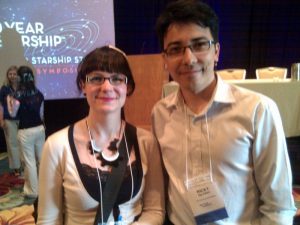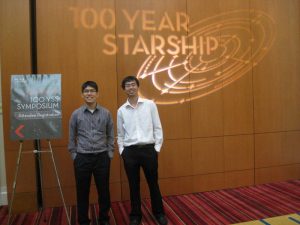100 Year Starship Study Symposium in Orlando, Florida October 30th to September 2nd. The goal of the 100 Year Starship Study is to create an organization with a small amount of seed money (one-time half a million dollars US) that can lead the development of an interstellar starship within the next century. At the symposium, I joined Tan Huei Ming and Eddie Cho, both at the National University of Singapore. They had independently submitted a document to the 100 Year Starship Study and I had met them in person while participating in DARPA “The Future of Make” executive panel in Singapore.
Initiated by Mr David L. Neyland (DARPA tactical technology office) and Dr Peter Worden (Director, NASA Ames Research Center). As a major driver of the whole endeavor, Mr Neyland kicked off the symposium and introduced the keynote speaker: Ariel Waldman of spacehack.org with her talk “Hacking Space Exploration”. [caption id="" align="aligncenter" width="300" caption="Ariel Waldman and me"]
 [/caption]
Ariel is a graphic designer that has always been fascinated by space and she talked about how doing something changes how we see something and that we don’t need to be an astronaut to do space stuff… don’t even need to be at NASA to explore stuff! “. We should not let lack of knowledge prevent people to send stuff into space: we need to make technology disruptively accessible. This can be done through competitions and communities such as Google Lunar X Prize, Lockeed Martin’s Aerospace Exploration, university rover challenge, Galaxy Zoo.
There was many talks on many tracks throughout the 3 days of the symposium, all very informative and interesting.
[caption id="attachment_1675" align="aligncenter" width="470" caption="A sample of the talks"]
[/caption]
Ariel is a graphic designer that has always been fascinated by space and she talked about how doing something changes how we see something and that we don’t need to be an astronaut to do space stuff… don’t even need to be at NASA to explore stuff! “. We should not let lack of knowledge prevent people to send stuff into space: we need to make technology disruptively accessible. This can be done through competitions and communities such as Google Lunar X Prize, Lockeed Martin’s Aerospace Exploration, university rover challenge, Galaxy Zoo.
There was many talks on many tracks throughout the 3 days of the symposium, all very informative and interesting.
[caption id="attachment_1675" align="aligncenter" width="470" caption="A sample of the talks"] [/caption]
I tried focusing on those that could help guide our developments in the short-term (next decade):
[/caption]
I tried focusing on those that could help guide our developments in the short-term (next decade):
- “Long-term computing” (Andreus Tziolas, Icarus Interstellar): Autonomous software and decision making processes for Icarus (presenting on behalf Dimos Homatas). Piece of software for a piece of unseen hardware that you’ve never seen before: centennial mission – twice as long as the history of computing itself. How much space is needed for a century mission? How much data will you collect? What about failures during that timespan (rebooting computers once a week)?
- “Big questions in Science-Fiction” (M. O’Keefe): who are we, how did we get here, what are we here for, what’s man’s place in the universe? The vision provided by science-fiction is one where technicians and scientists find answers to these questions. Direct inspirations from science-fiction designs.
- The Interstellar Vision: Principles and Practices (P. Gilster, Tau Zero Foundation): Near-by space missions will lead to an interstellar space mission because we will find those things that threaten Earth. Add the ability to find and nudge out the things that threaten.
- Creating Materials for the Starship (David Weiss, Eck Industries): Sophisticated alloys are the key to the metals we produce today. Transmutation is not as weird as it sound… We do it everyday (heat treatment) changes structure. Bombarding by radiation. High magnetic field processing. How to best spur materials development: challenge Grants, InnoCentive Challenge, X-Prize approach.
- Using video games to help the 100YSS” (Luke Blaize). Check out the Kerbal Space Program game.
- Marketing the Starship (Gordon Gould): Why a starship? Especially given the actual problems… Because we need a long-term goal. Thinks this is mostly a marketing problem: how to get humans excited about it.
- Project Icarus / Project Daedalus: fundamental science achievable in the near future. Making smaller versions of Daedulus (Pathfinder; 1/100th the mass of Daedalus Stage 2). Target speed: 100 au/YR, Isp: 50,000s, Vex: 500km/s).
- Building blocks to building a starship: repurpose “space trash” into new ships – DARPA’s Phoenix project.
- Jefferson Middle school presentation about their own one-month research in 100 YSS: Impressive presentation for a middle school: “Parliamentary democracy is the ideal system”. “People on long flight may go insane”. “Need to convince all religions to support this project”. “If space colonization is possible, communication is quite important”.
- Moon mining robot for the Lunabotics 2011 competition; an X Prize competition turned into a yearly student competition. See the ERAU Daytona Beach Lunabotics Competition 2011 video.
- Virgin Galactic talk (George Whitesides, President & CEO) with Sir Richard Branson doing a pre-recorded video encouraging participatings to the 100 Year Starship.
- ISS life support system (Monsi Roman, NASA): complete analysis of needs and effluents from astronauts.
- Small Body Exploration Technologies as Precursors for Interstellar Robotics (Robert J. Noble, Mark V. Sykes) : Learning how to explore small bodies here as a first step to interstellar flight. Challenges: AI, robotic governance, adapting to the unexpected. Noted the exotic idea of building an “Astrochicken”, a bio-cyber-electro-mechanical probe that can explore space independently.
- Going to Mars as a one way mission (Dirk Schulze-Makuch): Going to Mars as a one way mission (Dirk Schulze-Makuch), as a lifeboat, as a first human colony. Why one way mission? Cost of going one way: 20 billion$USD. Cost of round-trip: 100 billion$. This is due to lift-off fuel when coming back from Mars. He’s Looking for a 9-month study to produce a whitepaper on how to proceed technically and economically – need 80K$ from donors .

[…] I had a round trip ticket to the US east coast for the 100 Year Starship Study Symposium, me and Min Lin also wanted to visit friends and family in Montreal (Quebec, Canada) on the same […]